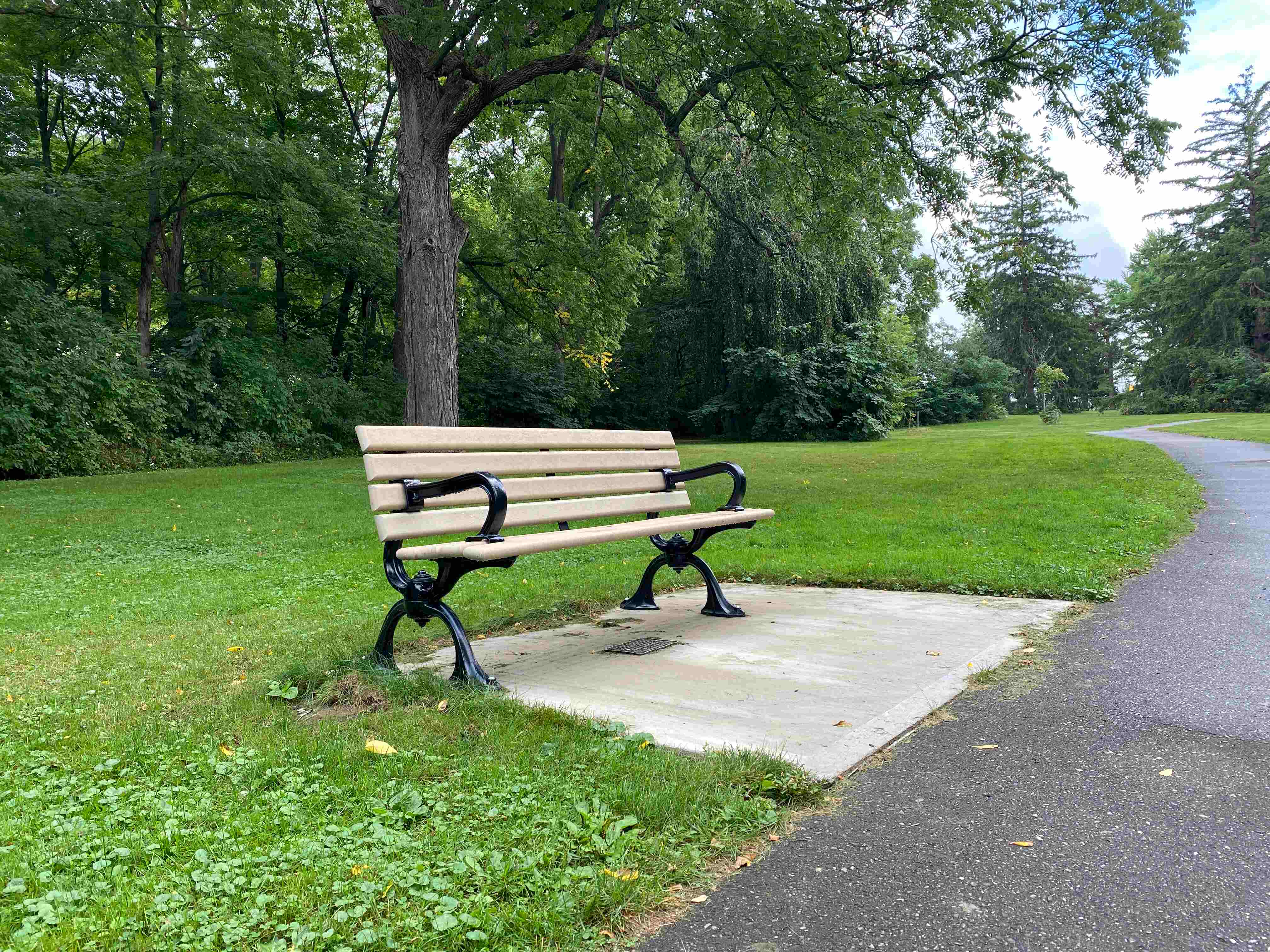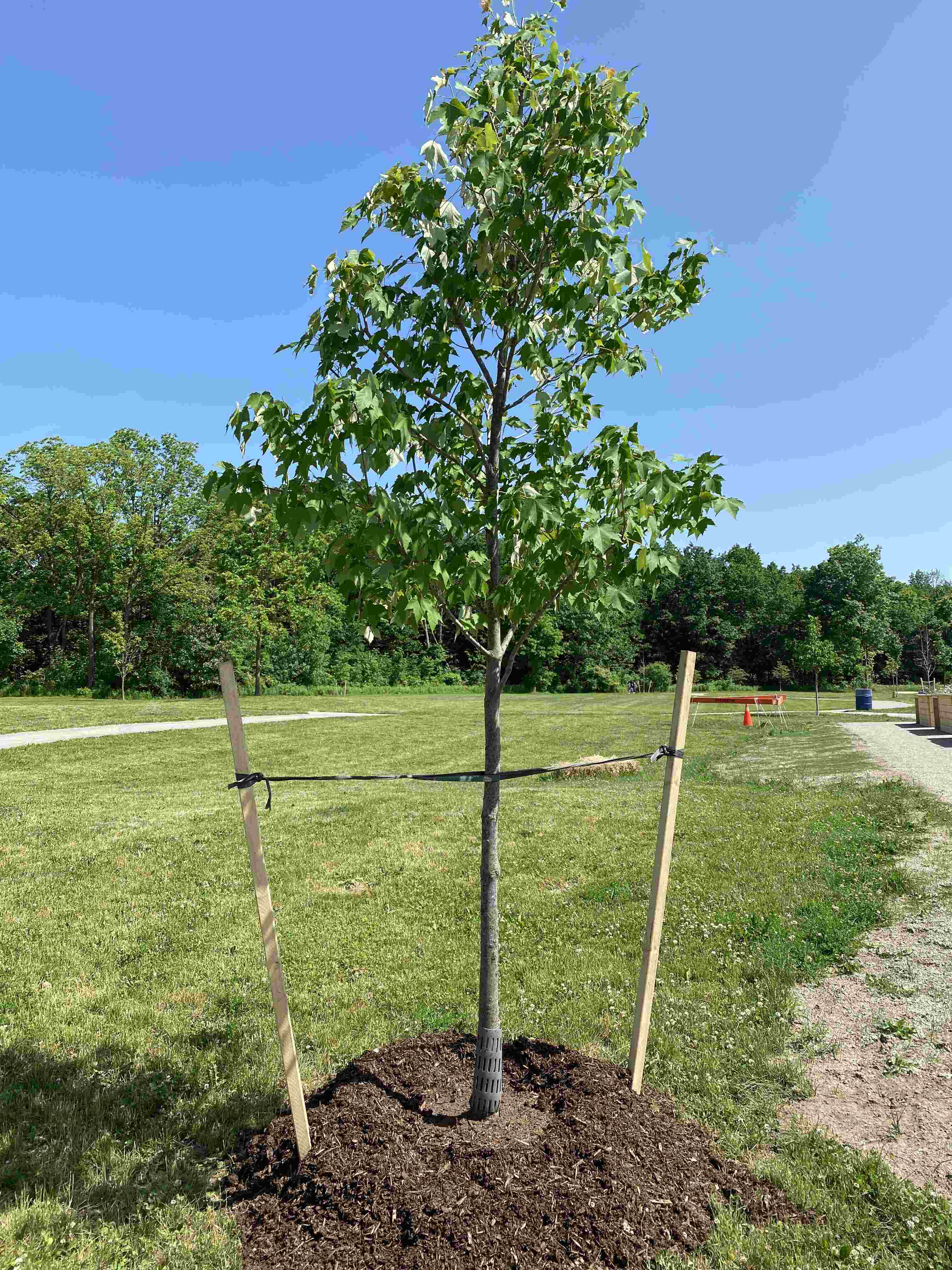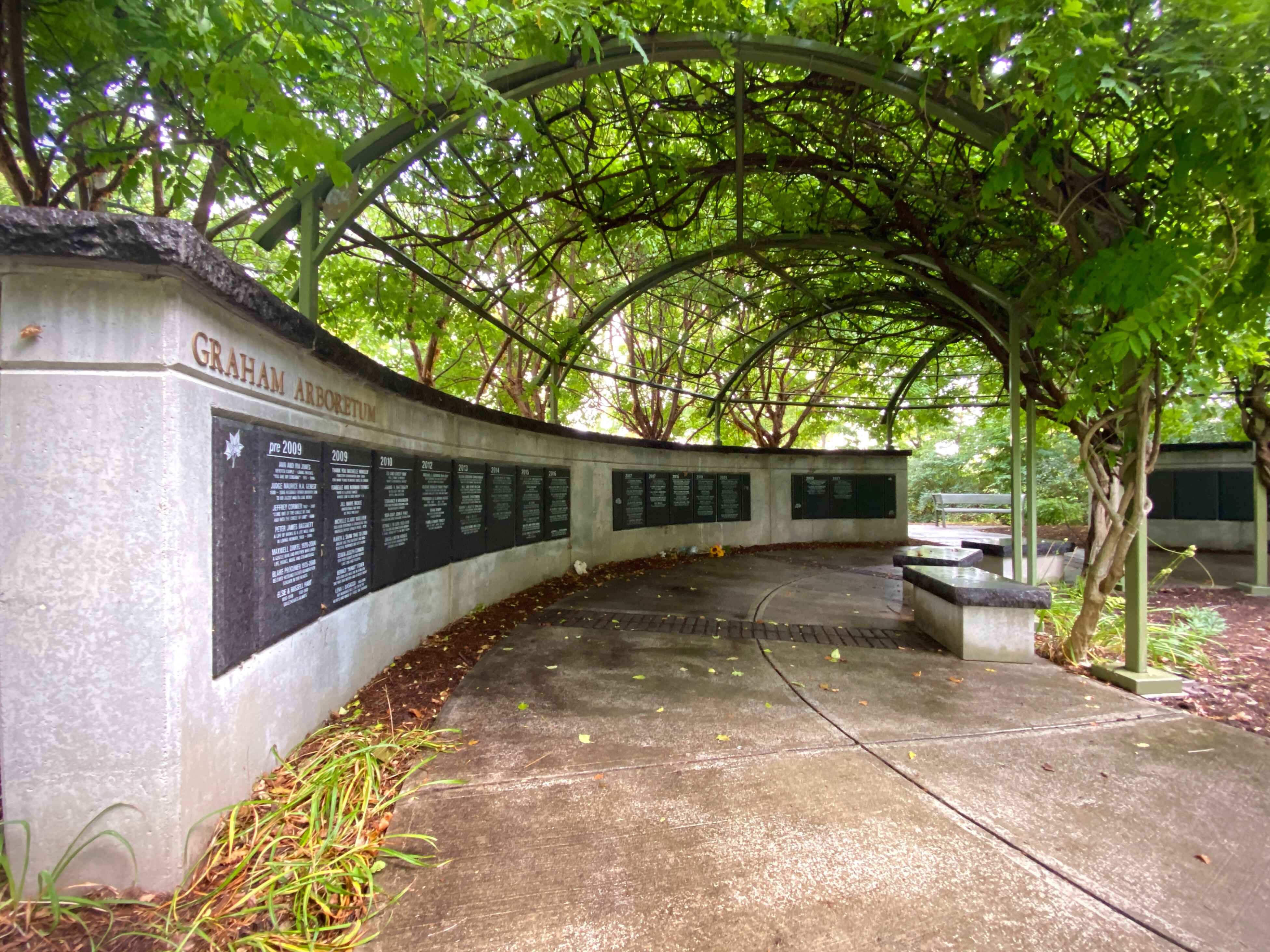A donation through the City’s commemorative program is a lasting and rewarding way to honour the memory of a loved one, celebrate a special occasion or recognize an accomplishment.
Your donation becomes a special tribute for your occasion, as well as an enduring gift to all Londoners within our public parks. Donations provided through the commemorative program are eligible for a charitable receipt.
The City offers three types of commemorative features including benches, trees, and our memory wall.
Commemorative benches
Commemorative benches offer a place for peaceful reflection. The donation amount for a commemorative bench is $4,500. The donation covers the costs of the bench, plaque, installation, maintenance, and repair of the bench for a duration of the lifetime of the bench which is estimated at about ten years. Commemorative benches will be installed in pre-approved locations only.
Commemorative bench applications are now closed.
Program details
- A maximum of 20 commemorative bench applications will be accepted by the City of London per year.
- The applicant’s donation covers the costs of the bench, plaque, installation, maintenance, and repair of the bench for a duration of the lifetime of the bench which is estimated at about 10 years.
- The City will replace a commemorative bench if necessary, during the lifetime of the bench. If a commemorative plaque has been vandalized or severely damaged, the City will pay for one replacement plaque within the lifetime of the bench. Additional plaque replacements will be an additional cost to the donor.
- Commemorative plaques will be ordered by the City once proofs have been approved by the donor and the City has received payment.
- Once a donation has been made, the bench becomes the property of the City of London.
- The payment deadline for a commemorative bench is 30 days after the date of the invoice.
- Installations of commemorative benches will occur in the following spring and is weather dependent.
- Commemorative benches are to be installed in pre-approved locations only.
- The placement of flowers, wreaths, or any other memorial item on, or near the bench is prohibited.
- If required, the City has the right to remove and relocate a commemorative bench. The City will do all their efforts to contact the donor prior to removal and relocation.

Commemorative trees
Help enhance our “Forest City” by making a donation to plant a commemorative tree in one of our parks. Commemorative tree applications have closed. Applications will re-open the first Monday in April and the application will be available on this webpage.
The City of London is part of the Carolinian eco-region. Carolinian trees improve air quality, provide food and habitat for insects and animals, create shade, and look beautiful too.
The donation amount for a commemorative tree is $550.00. The donation covers the cost, installation, and maintenance of the tree.
Locations may be determined based on individual park needs and optimal tree growth. Commemorative trees can be added in most parks other than Victoria Park, Ivey Park, the Civic Garden Area of Springbank, The Green in Wortley Village, and City-owned Golf Courses. Plaques cannot be installed with commemorative trees.
The City only offers native deciduous trees (50mm caliper) and offers selected species only.
Commemorative tree applications have closed. Applications will re-open the first Monday in April and the application will be available on this webpage.
Program details
- A maximum of 20 commemorative tree applications will be accepted by the City of London per year.
- The applicant’s donation covers the cost, installation, and maintenance of the tree.
- If the tree dies within two years of the initial planting, it will be replaced under warranty. Any replacements after five years will be an additional cost to the donor.
- Commemorative trees do not include plaques. Plaques cannot be installed in the future by the City, donor, or a third party.
- The City only offers native deciduous trees (50mm caliper) and offers selected species only.
- The City will examine the applicant’s requested location for a commemorative tree to ensure there are no conflicts with utility, recreation uses, or future improvements to the park. Please note that not all parks are available for commemorative trees and the City has the right to make the final decision as to the location.
- The payment deadline for commemorative trees is 30 days after the date of the invoice.
- Installations of commemorative trees will occur in the fall of 2024 and is weather dependent.
- The placement of flowers, wreaths, or any other memorial item on or near the tree is prohibited.
- If required, the City has the right to remove and relocate a commemorative tree. The City will do all their efforts to contact the donor prior to removal and relocation.
Tree species options
London is located in the Carolinian Life Zone, one of the most diverse natural environments in Canada. To help support and enhance this environment, certain tree species are recommended for Commemorative Trees. These tree species are native to our region and have the best chance for survival while maintaining a healthy and diverse public park system and urban forest.
List of recommended tree species
- Basswood/Linden (Tilia americana): A large tree than can grow up to 35 metres tall. Its leaves are large and heart-shaped with toothed edges. The fragrant yellow flowers and round graying-brown fruit hang from the centre of a leaf-like bract. When released, the bract acts like a helicopter wing and carries the seeds away in a breeze.
- Tulip Tree (Liriodendron tulipfera): A large, fast-growing tree that can grow up to 35 metres tall, with a thick trunk up to 160 centimetres in diameter. Its leaves are light green and turn yellow in the fall. This tree produces beautiful yellow-green flowers that bloom in the spring.
- Northern Hackberry (Celtis occidentalis): The largest native hackberry that can reach up to 15m tall. Its asymmetrical leave have long pointed tips that turn yellow in the fall. Single, reddish-purple fruits hang below the leaves and may persist into winter.
- Ironwood (Ostrya virginiana): This medium size tree can reach up to 12m tall and has alternating oval-shaped leaves with sharp teeth that turn a yellow-orange in the fall. Male flowers, called catkins, hang in early spring to release pollen.
- Downy Serviceberry (Amelanchier arborea): This is a small tree with alternating oval-shaped leaves that turn a yellow-orange-red in the fall. Clusters of white flowers appear in the spring, and berries ripen early to mid-summer.
- Red Maple (Acer rubrum): A medium-sized oval tree that can grow up to 25 metres tall, with a trunk that’s 60 centimetres in diameter. Its green lobed leaves turn an outstanding red in the fall. Seeds of maples are contained in “keys” that float down from the tree’s branches.
- Sugar Maple (Acer saccharum): A large tree that can grow up to 35 metres tall, and can live for more than 200 years. The shape of its leaves are well known – it is found on the Canadian flag as the Sugar Maple is the national tree of Canada. In the fall, its leaves turn yellow, brilliant orange, or red.
- Silver Maple (Acer saccharinum): A large, fast-growing tree that can grow up to 35 metres tall with a trunk that’s more than 100 centimetres in diameter. The silver maple is similar to the red maple – except that its leaves turn pale yellow or brown, not red, in the fall.
- Eastern Redbud (Cercis canadensis): This medium size tree has sweet pea like, fuchsia-coloured flowers in early spring with green heart shaped leaves that turn an attractive yellow in the fall. This tree will reach 8 to 10 metres at full maturity and supports many types of wildlife with the flowers and seed pods it produces.
- Blue Beech (Carpinus caroliniana): The blue beech is a medium sized tree that has dark green leaves in the summer, and which turn yellow, orange, and red in the fall. This multi-stem tree grows to be 8 to10 metres tall at full maturity with a round to oval crown shape.
- Common Horsechestnut (Aesculus hippocastanum): This is a large tree reaching 18 to 20 metres tall at full maturity, with an upright oval shape. This tree displays large, upright clusters of showy white flowers in mid-spring and promotes wildlife such as hummingbirds.

Memory wall
Memory Wall engraving applications are currently closed.
Located in Springbank Park’s Graham Arboretum, the memory wall features granite tablets with personalized engravings in a peaceful and reflective natural setting. The Memory Wall is located off of Arboretum Avenue just south of Storybook Gardens.
For a donation amount of $1500.00, a custom inscription will be included during the annual autumn engraving of the wall. A portion of your donation is used to help maintain and enhance the Arboretum.
Program details
- A maximum of 20 memory wall engraving applications will be accepted per year.
- The applicant’s donation covers the cost of the engraving, and a portion of the donation is used to help maintain and enhance the Graham Arboretum.
- Engravings will be installed once proofs have been approved by the donor and the City has received payment.
- The placement of flowers, wreaths, or any other memorial item around the memory wall is prohibited.
- The payment deadline for memory wall engravings is 30 days after the date of the invoice date.
- Installations of engravings will occur in the fall and is weather dependent.


Frequently asked questions (FAQ)
Why is there a limit on the number of application forms that are accepted yearly?
Over the past three years, there has been a significant increase in the number of commemorative feature installations. Having a limit of how many applications will be accepted helps support City staff coordinate efficient and manageable installations throughout the year.
Why are donors only allowed to choose pre-approved bench locations?
In past years, many donors have selected locations for commemorative benches in parks that already had several benches. This year, the City is providing pre-approved bench locations in parks that need benches.
What happens to the commemorative bench after 10 years?
If the commemorative bench becomes unsafe and unusable after 10 years, the City will remove it and the plaque will be provided to the donor. The donor will have the option to contribute to a new commemorative bench.
Why does the City not offer plaques with commemorative trees?
The City discontinued adding plaques with commemorative trees in 2008 based on feedback.
How do I pay for my commemorative feature?
Once the City has received your application form, an invoice will be mailed to the donor. Payments can be made by mailing a cheque to The Corporation of the City of London P.O. Box 5035, Rm 406 London, ON, N6A4L9, or through your financial institution to: payee London (city of) invoices. Please note that all payment methods will be listed on the mailed invoice.
When will I receive my charitable receipt?
Charitable receipts for the prior calendar year will be issued by February 28.
Donors who have not received their charitable donation receipt by March 13 should contact financialservices@london.ca
In your email, please include the following information:
- Subject line: Donation receipt for 202X (indicate the donation year)
- In the body of the email, please include:
- Name of donor
- Address of donor
- Date of donation
- Type of donation/Program donated through
- Amount donated
